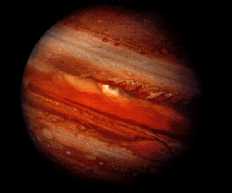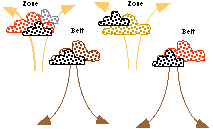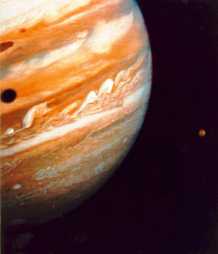This is an image of Jupiter.
Click on image for full size
Dr. Micheal Belton
An Overview of Jupiter's Atmosphere
The king of planets is aptly named because it not only has the most dymanic atmospheric motion, but also the most riveting cloud patterns and storms, and the most majestic appearance of the giant planets.
The dramatic appearance of Jupiter stems partially because the composition of Jupiter's atmosphere includes complex molecules such as ammonia and methane, as well as simple molecules such as helium, hydrogen, and sulfur.
The atmosphere of Jupiter is only a narrow surface layer, compared to the vast interior of the planet. The three clouddecks of Jupiter are to be found at different levels in the troposphere, while hazes of smog can be found higher in the atmosphere.
Jupiter is not much changed from its early evolution out of the primordial solar nebula, and in fact, may still be evolving.
You might also be interested in:

As on Earth, the atmosphere of Jupiter consists of a troposphere, stratosphere, mesosphere, and thermosphere. The troposphere is the region where the visible clouds are to be found. The stratosphere, as
...more
Atmospheres of the giant planets have definetely evolved from their formation out of the primitive solar nebula. How much they have evolved remains to be seen, however. Because of their enormous gravity,
...more
The mesosphere of Jupiter is a region of balance between warming and cooling. That essentially means that nothing happens there. Except for diffusion, the atmosphere is still. Upper reaches of the atmosphere,
...more
The stratosphere of Jupiter is a region of warming as determined by infrared measurements of methane (CH4) in the region. Like the troposphere, the stratosphere is warmed by the sun, warmed by Jupiter's
...more
The troposphere of Jupiter is where the clouds are. Clouds form in regions of strong atmospheric motion, when condensation takes place. The troposphere is the region rapidly stirred by vertical motions.
...more
On Jupiter, the winds in the belts and zones blow first in one direction, then in the opposite direction. Wind blows east in a belt, and west in a zone. The clouds rise up in a belt, and drop down in a
...more
The striped cloud bands on Jupiter are certainly not as straight as they appear to be in this picture! The picture shows that the striped pattern is divided into belts and zones, which are labeled. In
...more















